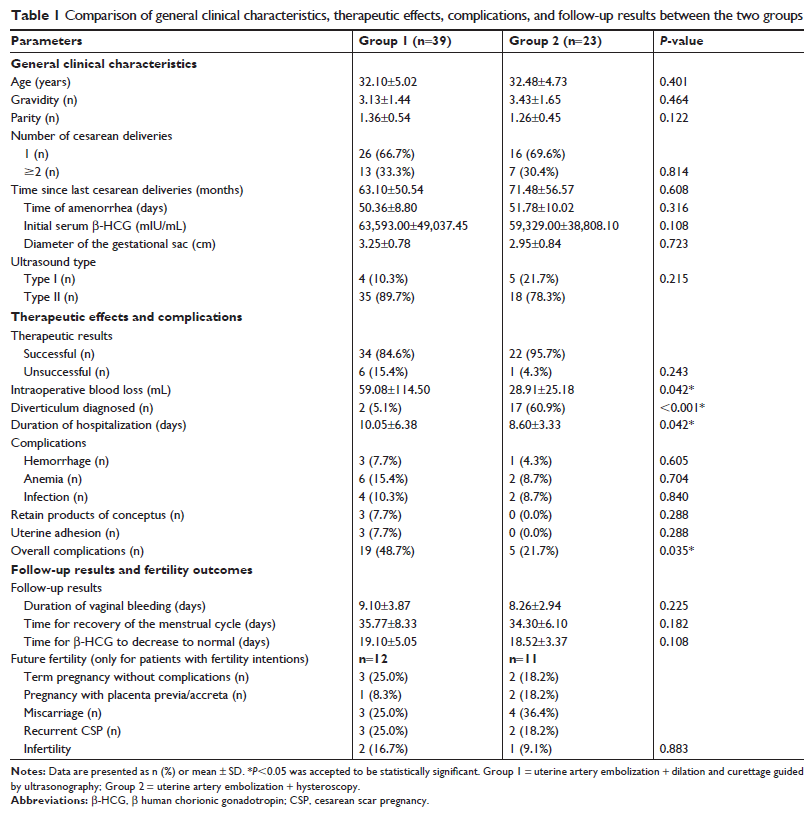9 1 1 5 0
论文已发表
注册即可获取德孚的最新动态
IF 收录期刊
- 2.6 Breast Cancer (Dove Med Press)
- 3.9 Clin Epidemiol
- 3.3 Cancer Manag Res
- 3.9 Infect Drug Resist
- 3.6 Clin Interv Aging
- 4.8 Drug Des Dev Ther
- 2.8 Int J Chronic Obstr
- 8.0 Int J Nanomed
- 2.3 Int J Women's Health
- 3.2 Neuropsych Dis Treat
- 4.0 OncoTargets Ther
- 2.2 Patient Prefer Adher
- 2.8 Ther Clin Risk Manag
- 2.7 J Pain Res
- 3.3 Diabet Metab Synd Ob
- 4.3 Psychol Res Behav Ma
- 3.4 Nat Sci Sleep
- 1.9 Pharmgenomics Pers Med
- 3.5 Risk Manag Healthc Policy
- 4.5 J Inflamm Res
- 2.3 Int J Gen Med
- 4.1 J Hepatocell Carcinoma
- 3.2 J Asthma Allergy
- 2.3 Clin Cosmet Investig Dermatol
- 3.3 J Multidiscip Healthc

子宫动脉栓塞术后分别在超声与宫腔镜引导下施行扩张和刮宫术治疗剖宫产瘢痕妊娠的临床疗效分析
Authors Qiu J, Fu Y, Xu J, Huang X, Yao G, Lu W
Received 18 August 2018
Accepted for publication 13 November 2018
Published 7 January 2019 Volume 2019:15 Pages 83—89
DOI https://doi.org/10.2147/TCRM.S184387
Checked for plagiarism Yes
Review by Single-blind
Peer reviewers approved by Dr Andrew Yee
Peer reviewer comments 2
Editor who approved publication: Professor Deyun Wang
Purpose: The
purpose of this study was to investigate the efficiency, complications, and
subsequent fertility outcomes of two methods in treating patients with cesarean
scar pregnancy (CSP) after receiving uterine artery embolization (UAE)
treatment.
Patients and methods: A total
of 62 CSP patients who visited our hospital and underwent UAE from January 2013
to January 2018 were retrospectively analyzed. Patients were either treated by
dilation and curettage (D&C) guided by ultrasonography or hysteroscopy. The
differences of related clinical indicators, clinical efficacy, complications,
and subsequent fertility outcomes between the two groups were analyzed.
Results: The rates
of therapeutic success of the ultrasonography group and hysteroscopy group were
84.6% and 95.7%, respectively, the difference was not statistically significant
(P =0.243). However,
the intraoperative blood loss, duration of hospitalization, and overall
complications were significantly lower in hysteroscopy group compared with
D&C guided by ultrasonography group (P <0.05 for all). Meanwhile, hysteroscopy had the
advantage of discovering potential diverticulum in the lower segment of
anterior wall of uterus (P <0.001).
Conclusion: D&C
guided by ultrasonography or hysteroscopy for the treatment of CSP after UAE
resulted in similarly good clinical outcomes. Compared with treatment of
D&C guided by ultrasonography, hysteroscopy had less complications and had
the advantages of discovering diverticulum. It can be used as an effective way
for the treatment of CSP.
Keywords: cesarean
scar pregnancy, uterine artery embolization, dilation and curettage,
ultrasonography-guided, hysteroscopy
